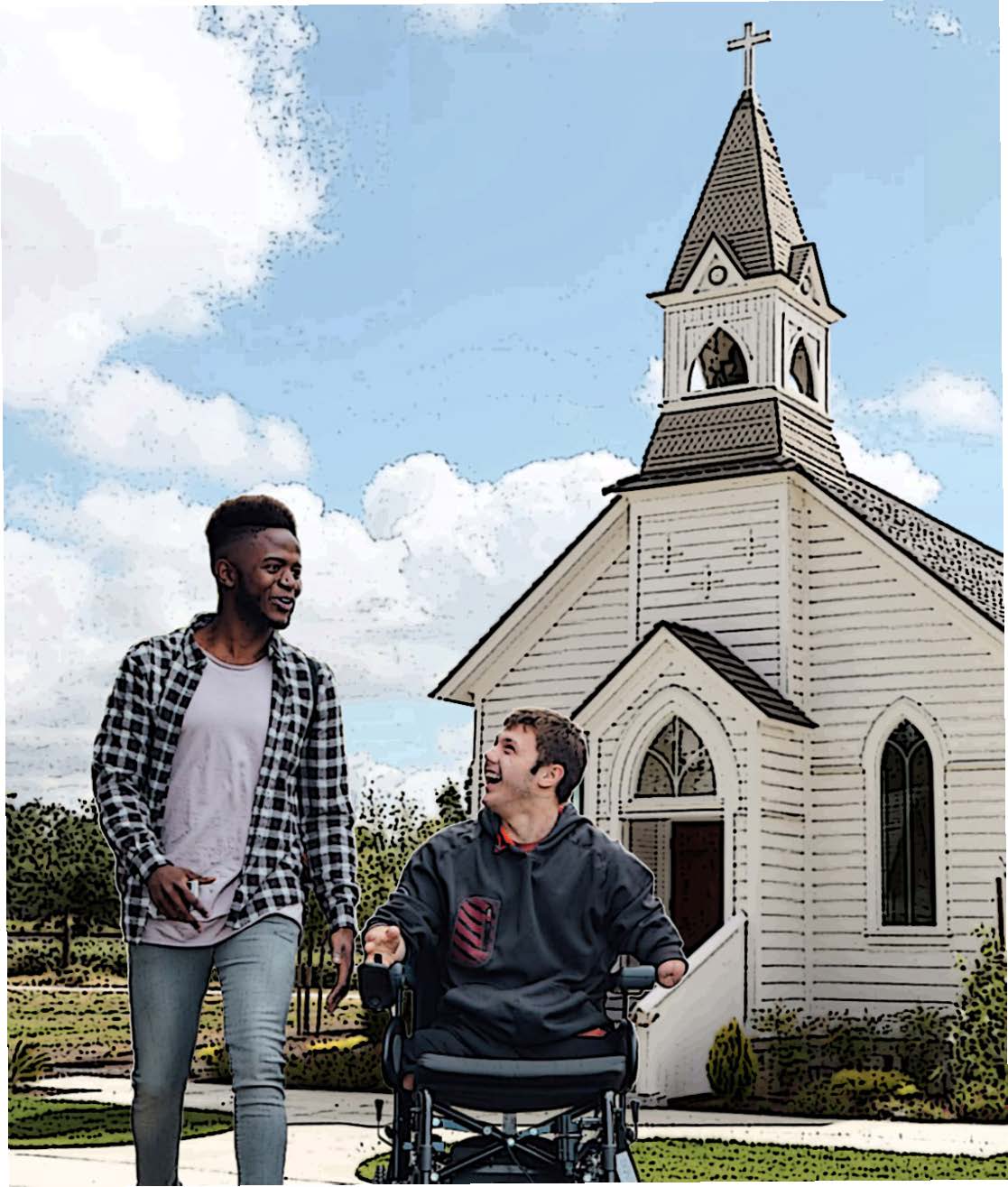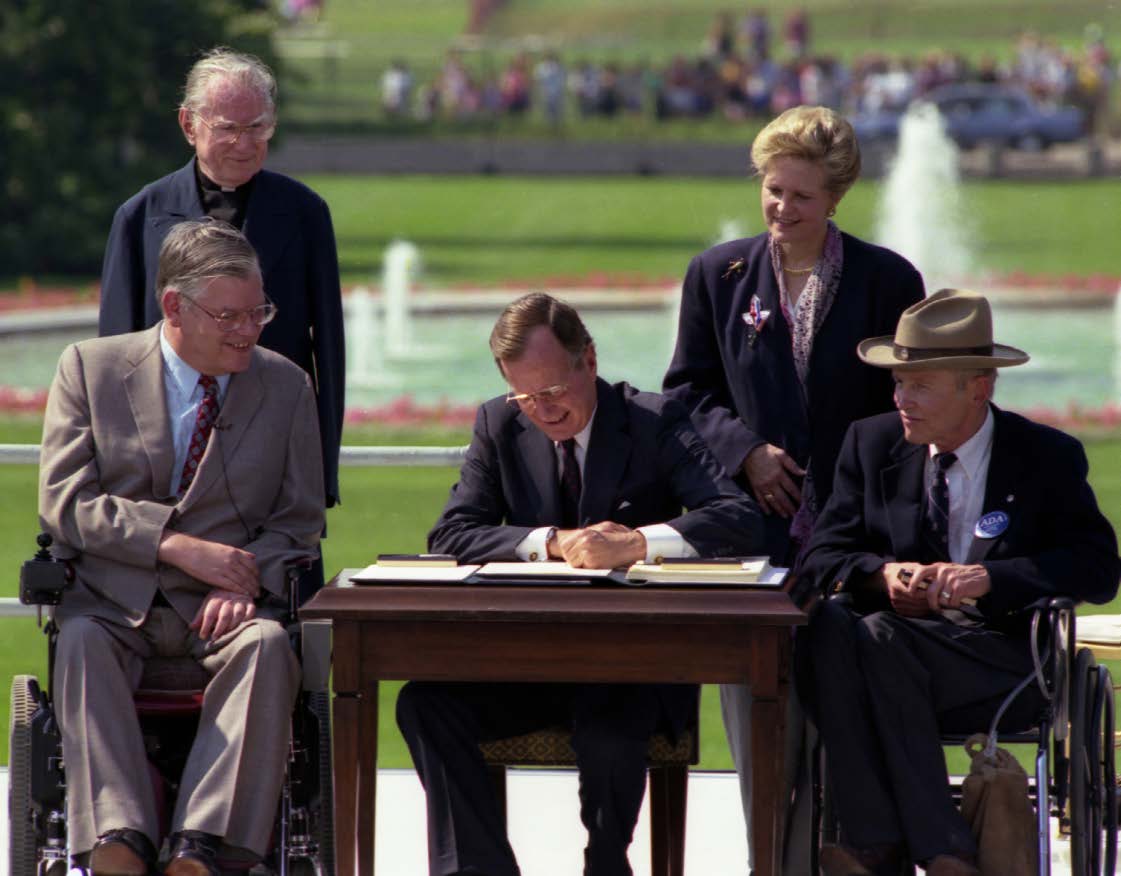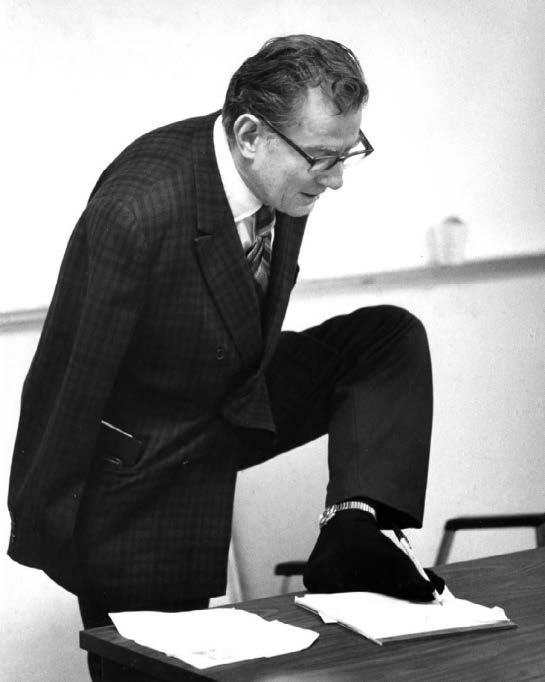THE AMERICAN CHURCH AND THE AMERICANS WITH DISABILITIES ACT
BY JOHNNY PAYNE ME D

With or without churches' legal obligation to the ADA, there exists a moral responsibility and a set stage to facilitate the fulfillment of its principles.
Rev. Harold Wilke, can be seen in one of the most iconic American photos, alongside President George W Bush and others in 1980, at the signing of the Americans with Disabilities Act (ADA). Wilke was a minister in the United Church of Christ, and many others like him worked tirelessly for greater disability awareness and equality.
At the signing ceremony, Wilke delivered an invocation, an unprecedented event at a bill signing. He spoke of "the breaking of the chains which have held back millions of Americans with disabilities." Here, he did not speak of literal chains of disability, but of the physical and attitudinal barriers of American culture. Religious groups have unique opportunities to promote inclusion and empowerment for people with disabilities. From jobs, relationships, community connections, these groups provide gateways into community life for their members. Although changing somewhat rapidly, Christian churches continue to represent the greatest majority of religious groups in America (65% in 2019, 75% in 2015, 85% in 1990 per Pew Research Center). The American church holds tremendous tools and opportunities for access to the community for people with disabilities. However, according to the 2019 Census, about 20% (60 million) of Americans have a disability, but disability leaders estimate only about 15% (9 million) of people with disabilities attend any kind of faith tradition.
The ADA is considered by many to be the most groundbreaking piece of American legislation since the Civil Rights Act of the 1960s. Instated as law in 1990, the ADA prohibits discrimination against individuals with disabilities in all areas of public life. This includes jobs, schools, transportation, and all public and private places that may be accessible to the general public. The law, as it was drafted and approved, attempted to ensure people with disabilities have the same rights and opportunities as everyone else. The law provided protection to people with disabilities similar to those provided to individuals on the basis of race, color, sex, national origin, age, and religion. Before the ADA, no buildings were required to have ramps, parking lots did not require "handicapped spots", and public transportation did not have to accommodate people who used wheelchairs. Anyone older than 30 years at the time of this article was born when people with disabilities people lacked the same rights as their fellow Americans.

SIGN OF THE TIMES: On July 26, 1990, President George Bush signed the Americans with Disabilities Act into law. With him on the South Lawn of the White House are (left to right, standing) Rev. Harold Wilke and Swift Parrino, Chairperson, National Council on Disability,(from left to right, sitting) Evan Kemp, Chairman of the Equal Employment Opportunity Commission, and Justin Dart, Chairman of the President's Committee on Employment of People with Disabilities.
The ADA is divided into five parts or titles. Under title three, businesses that own, lease, lease to, or operate public accommodations like hotels, restaurants, theaters, shopping centers, banks, museums, zoos, daycare centers, private schools, and health spas must provide 'reasonable accommodation' for people with disabilities to access and participate with their services and spaces. However, all religious groups are completely exempt from this title and from the ADA entirely. All religious groups' facilities, programs, and activities, whether they are religious or secular in nature, are completely exempt. The title 'religious groups' include places of worship, such as mosques, synagogues, and churches. However, the title also encompasses any places or programs controlled by the group including schools, hospitals, daycare centers, adoption agencies, thrift shops, shelters, and food banks.
The American Church's historic relationship with the ADA and government overall is incredibly complicated and multifaceted. From the introduction of the ADA in Congress in 1989, religious groups, particularly the American Church, have aggressively resisted participation. Exemption of these groups has been upheld primarily on the basis that requiring religious entities to comply with the ADA amounts to impermissible government interference with religion. For example, in 1989 William Bentley Ball, an attorney representing the Association of Christian Schools International and numerous other Christian entities, lobbied against the ADA for two reasons: the cost of making schools accessible and concerns about government intrusion into religious institutions. In July 1989, he wrote to the director of the Office of Policy Development at the White House, "Religious exercise, within the meaning of the First Amendment will be directly involved if churches and religious schools are not expressly exempted from the terms of the ADA." Ball also argued that there was no compelling state interest in religious organizations being accessible noting, "Nothing has been shown to indicate that there is a national necessity to apply the ADA Bill to churches, religious schools, and other ministries."
The outcome of exempting Christian churches and schools from the ADA has been significant. Very few other religious groups made similar arguments to Ball on behalf of Christian groups lobbying against being included in the ADA. Christians stood nearly alone against access for disabled people as part of Religious Groups. Many people with disabilities feel this outcome communicated that they did not belong in mainstream U.S. Christianity, as churches either actively opposed the ADA or passively didn't abide by it because they weren't required to do so legally.

BEST FOOT FORWARD: When Harold Wilke accepted a pen from President George H. W. Bush at the signing of the ADA, he grasped it with his toes; he had been born without arms. In 1975 Wilke founded The Healing Community Project to help churches change their attitudes and architecture to welcome persons with disabilities.
Before the ADA, people with disabilities experienced inaccessibility to their communities. After the ADA, many more pathways into community participation were formed for them, but not through the American Church. Leah Smith, Project Coordinator for the Center for Dignity in Healthcare for People with Disabilities notes, "We know this message was received by the disability community when we see that people with disabilities are 40% more likely than those without disabilities to report that they do not attend church. Further, they are 28% more likely to report that church is not important in their lives".
Dr. Erik Carter, Cornelius Vanderbilt Professor of Special Education at Vanderbilt University, has gathered quantitative research on people with intellectual and developmental disabilities in the American Church. He notes that:
• 56% of parents keep their children from participating in church activities because they experience a lack of support for their child.
• 32% of families changed their place of worship because they or their child was not 'included or welcomed'.
• 54% of parents say they have never been asked about the best way to include their child in religious activities
Bill Gaventa, past President of the Americans Association of Intellectual and Developmental Disabilities (AAIDD) notes, "Most advocacy around disability has been in the public policy and human rights arenas. Rights may get you physically into a place that was inaccessible before, but they won't get you relationships. Beyond inclusion is belonging. While people were worried about how a rights-focused ADA would impact church hiring, or forcing them to accept people with HIV or other disabilities, it abdicated the moral call of welcome and the crucial role of religious groups as places of relationship, and abdicated the role of the church, for a long time, in advocacy circles."
Because religious groups are exempt from the ADA as law, religious leaders have to empower their members to uphold ADA practices in terms of morality and decency—and civil rights. As an example, in 1993, the Christian Reformed Church of North America called its members to become ADA compliant to stop what they noted was tantamount to "churches committing disability discrimination even while at the same time they are trying to help people."
There is much that can be done to support people with disabilities within the American Church, and there is much work to do. Dr. Gaventa suggests starting by asking people with disabilities and their families what they feel, to ask them what their experience is or has been with churches. He also notes that if churches do approach being more inclusive towards people with disabilities, they should expect residual anger that has been hiding or deeply buried by people with disabilities. Even so, as churches pursue inclusivity, they should start by having hard conversations to know what people with disabilities experience.
Rev. John Jay Frank, Ph.D., author of several books, including Turning Barriers Into Bridges, provides a theological rationale for the concept of universal design. In designing programs, activities, materials, and spaces, consideration of diverse abilities may be included in the planning process. This concept, called universal design, can be applied in all areas of religious group activity, from leadership and design to membership and participation. He outlines a passage from the Bible, "Do not to dig a hole and leave it unattended, so as to avoid accidental injury or death, and to put up a railing around a porch, so people do not fall off or drop things on those below, and not to put a stone in the road where someone who is blind may trip on it, and not lead someone who is blind astray." (Ex. 21:33-34, Lev. 19:14-15, Deut 22:8, Deut. 27:18). He notes, "Christians should take care not to harm others with what we create and do, regardless of whether or not anyone falls into the holes we dig."
Costs have historically been held as a reason for religious groups to not be held to the ADA. Costs for accommodation can be burdensome, especially when spent sporadically when special needs for accessibility arising. However, if resources are budgeted towards universal design and accessibility during design and planning, costs can be much smaller. As noted previously, about 20% of Americans have a disability. Therefore about 20% for each overall project may be directed towards including those individuals in church participation. For example, a church remodeling may cost $100,000. So about $20,000 could go for accessibility features. $10,000 may be spent on a new sound system so $2,000 might go for an earloop system for hearing impairments. A new instrument might cost a certain amount. So about 20% of that cost might be directed towards the purchase of large-print songbooks or signs.
The leadership of a church might adopt (and make known) a Church Disability Policy that includes adhering to the ADA to mitigate discrimination towards and provide a welcome space for people with disabilities. Churches might follow the lead of the Christian Reformed Church of North America as they universally adopted a disability policy for their entire organization. Individual members may also commit to providing an environment of universal design within their own area of responsibilities. A person who makes computer slides for a worship service might take the responsibility of making them accessible with high contrasting colors. A person who produces a church activity, bulletin, or newsletter, might take responsibility for making their material accessible. A religious teacher might provide a sermon outline or study notes for people who experience difficulty managing attention for various reasons. Gluten-free wafers or sugar-free desserts at religious events are simple ways to provide welcome.
With or without churches' legal obligation to the ADA, there exists a moral responsibility and a set stage to facilitate the fulfillment of its principles. Rev. Herald Wilkes entrusts us with this endeavor as he completes his invocation at the ADA signing. May his words provide a strong charge for American culture now, as they did then: "Today we celebrate the granting… of full citizenship and access to the promised land of work, service, and community.… strengthen our resolve as we take up the task knowing that our work has just begun… Bless the American people and move them to discard those old beliefs and attitudes that limit and diminish those among us with disabilities". •
KEEPING THE FAITH : ACCESSIBILITY RESORCES
For more information on access to religious services as it relates to individuals with disabilities, please visit: DISABILITY CONCERNS Accessibility Audit tool network.crcna.org/disability-concerns/accessibilty-audit Church policy on disability template network.crcna.org/church-admin-finance/church-policy-disability
ABOUT THE AUTHOR:
Johnny Payne is the Mental Health Coordinator at the Orange Grove Center in Chattanooga TN.